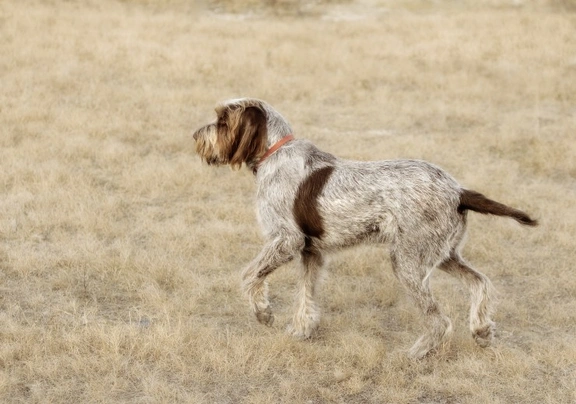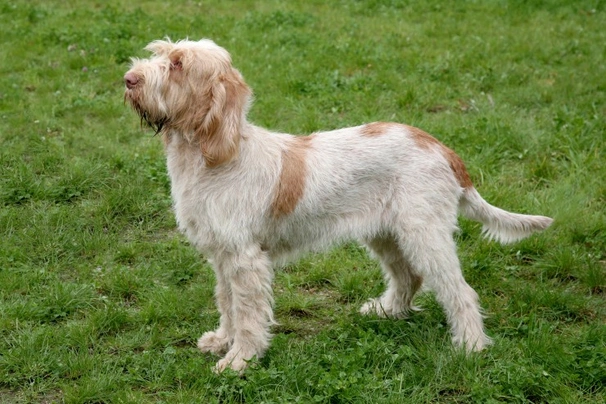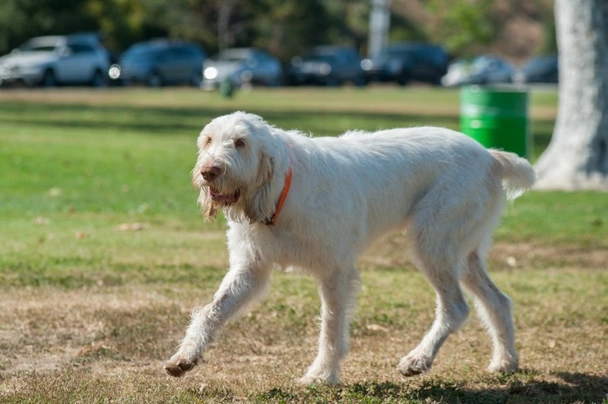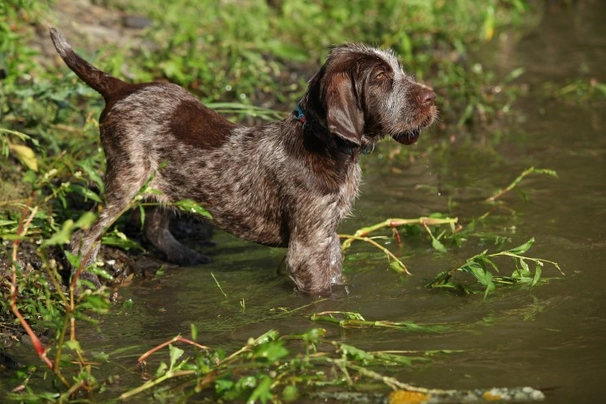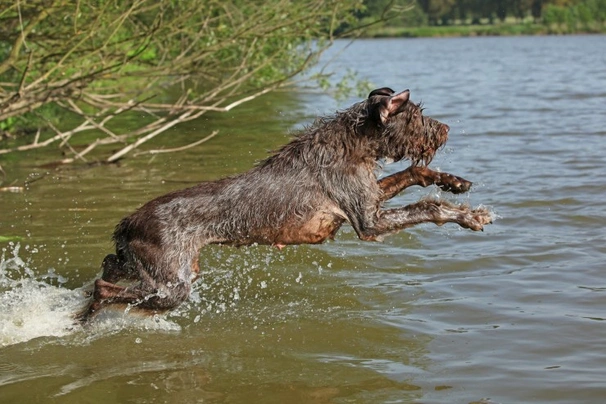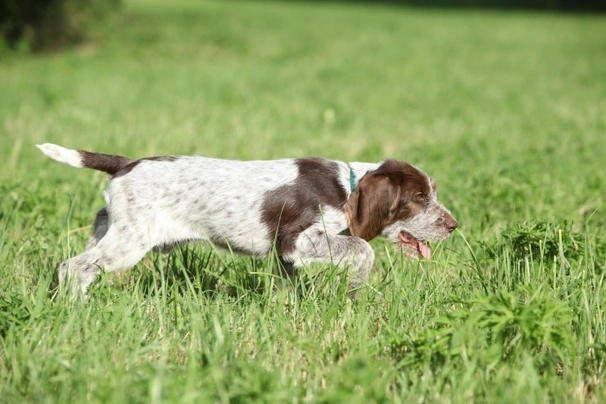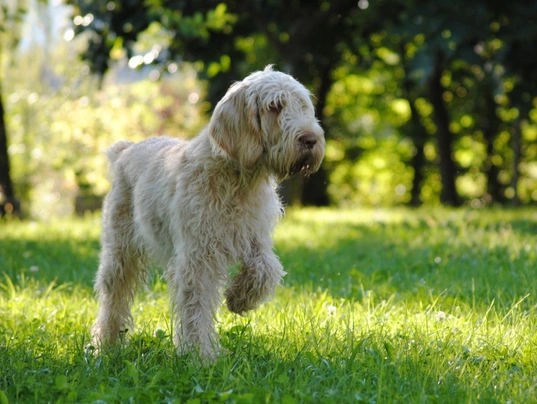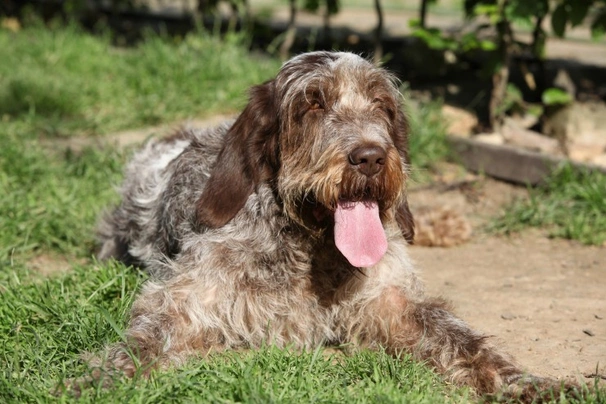Italian Spinone
Pros
Cons
Introduction of the Italian Spinone
The Italian Spinone is a newcomer here in the UK but these attractive gundogs are already proving to be a success both in the field and in a home environment. They are known to be loyal and affectionate characters by nature and in Italy they have been highly prized for centuries being among the oldest of their native breeds. They boast a very distinctive look with their moustaches beards and eyebrows which gives them a very endearing almost human-like appearance.
The Italian Spinone is known to be very placid and laid-back which in short means they are a great choice as family pets companions as well as working dogs. However their breed numbers remain quite low in the UK which means that well-bred puppies can command a lot of money and waiting lists tend to be long.
History of the Italian Spinone
Although the exact origins of the breed remain a bit of a mystery some people believe that Spinoni have the same lineage as Setters but this is yet to be proved. Other breed enthusiasts think the breed is a descendant of the Coarse-haired Segugio a hound that existed back in the Middle Ages. But the most favoured origin of the Italian Spinone is thought to be that they come from much further afield namely the East. It is also thought that Spinoni were developed by crossing Griffons and that the “true” breed types originated in Russia before arriving in the Italian regions of Venetia and Lombardy.
The first Italian Spinoni were imported to the UK in 1981 by a lady called Mrs. Mary Moore who set up a breeding programme which established the breed throughout the UK. Full Kennel Club recognition was granted in 1994 when these lovely dogs were taken off the “rare breed” register. With this said in their native Italy the breed has always been a highly prized “hunt point and retrieve” gundog because they can work over more challenging terrains which includes marshlands and woodlands with no trouble at all.
As previously mentioned Spinoni were originally bred to hunt point and retrieve a task they proved to excel at especially when retrieving game and waterfowl. But over the centuries these charming dogs found favour in their native Italy both as working dogs and as companions thanks to their personable and fun-loving natures when kept in a home environment which they adapted to exceptionally well.
Since the breed was introduced to the UK in 1994 their popularity has slowly increased both with hunters who like a reliable Hunt Point and Retrieve gundog working alongside them in the field or with people in a home environment. With this said anyone wishing to share their home with an Italian Spinone would have to go on a breeder's waiting list because few well-bred puppies are registered with the Kennel Club every year and they can often command a lot of money.
Interesting facts about the breed
- Is the Italian Spinone a vulnerable breed? No although anyone wishing to share a home with a Spinone would need to register their interest with breeders for the pleasure of doing so and puppies are often very expensive
- The Italian Spinone has hunting in their make-up having been bred for centuries to Hunt Point and Retrieve a job they are especially good at
- They have amazing scenting abilities and are tireless when they pick up a scent when it comes to tracking their prey down
- Males are known to go through what can only be described as a “difficult teenage” stage which means they can be “hooligans” if left to their own devices
- Females are known to be “hormonal” and they have seasons which can be anything from 6 to 9 months apart with their first one starting when they are around 12 months old
- The plural of Spinone is Spinoni and not Spinones
- Traditionally a Spinone’s tail was always docked but since the law banning the procedure came into effect in 2007 tail docking is now illegal with the exception being for some working breeds and if a dog suffers from some sort of health issue that requires their tails to be docked. The procedure must be agreed and authorised before being performed by a qualified vet
Appearance of the Italian Spinone
Height at the withers: Males 60 - 70 cm Females 58 - 65 cm
Average weight: Males 34 - 39 kg Females 29 - 34 kg
The Italian Spinone is known for their "human-like" expressions which are traits that make these large dogs so very endearing. Their heads are quite oval shaped with dogs having a well pronounced occiput and nicely defined median furrow. Their muzzles have a good depth to them and can be slightly arched when seen in profile but square when seen from the front. Upper lips are slightly rounded with a visible fold at each of the corners of a dog's mouth. Their noses are large and spongy looking boasting wide-open nostrils.
Their eyes boast an almost human-like look about them being large almost round and open being set well apart on a dog's face with eyelids that are close fitting. The iris is an ochre colour but can be various shades to match a dog's coat. Their ears are nicely pendulous and triangular shaped being slightly rounded at the tips supple and fine to the touch.
Ears are covered in dense hair which is intermingled with longer hair that becomes denser around the edges. Dogs carry their ears low with the forward edge touching their cheeks. The Spinone has a strong jaw with a perfect scissor bite where their upper teeth neatly overlap their lower ones.
Their necks are well-muscled and powerful being relatively short and showing a distinct crest from the nape before merging neatly into the shoulders. Forequarters are strong powerful and muscular with dogs having well laid-back shoulders with the tips of them being set well apart. Front legs are straight and strong with a good amount of oval bone nicely defined tendons and dewclaws.
The Spinone boasts a compact nicely proportioned body with a topline that gently slopes from the withers before rising gently to broad well-muscled loins. A dog's croup then falls gently away to where their tail is set. Chests are deep and broad with dogs having quite a prominent breastbone. Ribs are well sprung and open being carried well back. Dogs have a very slightly tucked up belly which adds to their athletic appearance.
Hindquarters are strong with dogs having broad slightly sloping but muscular croups. Thighs are also broad muscular and long with dogs having powerful back legs that may or may not have dewclaws. Front feet are large being compact and round with thick pads and well arched toes that are covered in thick hair. Their back feet are slightly more oval shaped but otherwise boast having the same characteristics as their front ones. Tails are thick at the base and set level to a dog's croup which they carry either down or horizontally.
When it comes to their coat the Spinone has close fitting skin that's thick and leathery to the touch. Their coats are coarse dense and it lies close but there is no undercoat. The hair on their eyebrows moustache and beard is thicker and longer than on the rest of a dog's body. The hair on the backs of their legs is made up of a rough brush but does not form any sort of fringe. The acceptable breed colours for Kennel Club registration are as follows:
- Brown
- Brown & White
- Brown Roan
- Orange & White
- Orange Roan
- Roan
- White
- White & Brown
- White & Orange
- White & Orange Roan
It is worth noting that the acceptable colours for Kennel Club registration for the breed can differ from those set out in the Breed standard.
Gait/movement
When an Italian Spinone moves they do so in a relaxed free manner and capable of maintaining a fast trot for extended periods of time. When a dog moves they always keep a nice level topline which is a distinct characteristic of the breed.
Faults
The Kennel Club frowns on any exaggerations or departures from the breed standard and would judge the faults on how much they affect a dog's overall health and wellbeing as well as their ability to perform.
Males should have both testicles fully descended into their scrotums and it is worth noting that a dog can be a little lighter or heavier as well as slightly taller or shorter than set out in the Kennel Club breed standard which is only given as a guideline.
Temperament of the Italian Spinone
Thanks to their breeding the Italian Spinone boasts being a placid laid-back character and one that's a joy to have around. In the right hands and with the correct amount of socialisation from a young age and training in the right hands and environment these charming dogs are easy to train. They learn new things quickly but this means they are quick to pick up bad habits too which is something owners must bear in mind.
They are a very good choice for first time owners because an Italian Spinone loves to please and will do their best to get things right. However they are high energy dogs and as such they need to be given a ton of physical exercise on a daily basis for them to be truly happy well-rounded dogs. Being so intelligent they also must be given masses of mental stimulation otherwise boredom will quickly set in which could result in dogs developing some unwanted behavioural issues.
It's important to bear in mind that these lovely dogs take a long time to mature and as such their training must start early but it cannot be rushed. Another thing about the Italian Spinone is that they are known to slobber and snore which could be a problem for anyone who is very house proud or who has trouble sleeping. With this said these dogs do very well when living in the countryside and people who boast very large back gardens. If an Spinone is not given enough mental stimulation and daily exercise they can develop separation anxiety. With this said they do so much better living in a home environment where one person usually stays in when everyone else is out so they always have company.
Are they a good choice for first time owners?
The Italian Spinone is a good choice for first time dog owners because they are so amenable and people-oriented loving nothing more than to please and to entertain their families. They are particularly good with young children and older people too although playtime can get a bit boisterous at times.
What about prey drive?
For centuries Spinoni were bred to hunt point and retrieve which are traits that are deeply embedded in a dog’s psyche. As such they do have a high prey drive and will happily take off following their noses if they pick up an interesting scent or spot something interesting in the distance. As such care should always be taken as to when and where a Spinone can run off the lead more especially if there is livestock or wildlife close by.
What about playfulness?
Spinoni are known to have a very playful and fun-loving side to their natures. They enjoy it when they are being entertained and when they can entertain with their clown-like antics. They are known to be a little mischievous when the mood takes them and being so clever a Spinone quickly learns how to get their own way which is why they must be handled with a gentle yet firm hand right from the word go.
What about adaptability?
The Italian Spinone is a great choice of family pet for people who lead active outdoor lives and who have secure back gardens a dog can safely roam in whenever possible. They are not suited to apartment living because these dogs need to be kept busy both mentally and physically to be truly happy well-rounded characters.
What about separation anxiety?
Spinoni form strong ties with their families and dogs are never very happy when they find themselves left on their own for longer periods of time. They are better suited to people who either work from home or in households where one person stays at home when everyone else is out so they are never alone for any length of time which could see a dog suffering from separation anxiety. This can lead to them being destructive around the home which is a dog's way of relieving any stress they are feeling and a way to keep themselves entertained which could include barking incessantly to get some attention.
What about excessive barking?
Some Italian Spinone like the sound of their own voices a little too much which is something that needs to be gently nipped in the bud when a dog is still young being careful not to frighten them bearing in mind that they are known to be ultra-sensitive by nature and do not respond well to raised voices. Others will only bark when there are strangers about or when something they don't like is going on in their surroundings as a way of alerting their owners.
Do Italian Spinone like water?
Most Spinoni love swimming and will take to the water whenever they can more especially when the weather is hot. However if anyone owns a dog that does not like water they should never force them to go in because it would just end up scaring them. With this said care should always be taken when walking a Spinone off the lead anywhere near more dangerous watercourses just in case a dog decides to leap in and then needs rescuing because they cannot get out of the water on their own.
Are Italian Spinoni good watchdogs?
Spinoni are not very good watchdogs because they are friendly and social dogs by nature. They enjoy greeting everyone which includes other dogs as well as people. However this is not to say that a dog won’t bark to let an owner know there is someone at the door or when strangers are close by or when something they don’t like is going on around them.
Intelligence / Trainability of the Italian Spinone
Being so intelligent and eager to please in the right hands an Italian Spinone is easy to train. However their training must be consistent and always fair because they are known to be quite sensitive by nature. As such any harsh correction or heavy-handed training could well ruin a dog's spirit something that needs to be avoided at all costs. The Spinone responds well to gentle positive reinforcement training remembering that these dogs mature slowly. In short their training can never be rushed but needs to be done with a lot of understanding and patience to achieve the best results.
Like all puppies Italian Spinoni puppies are incredibly cute and it is all too easy to spoil them when they first arrive in their new homes. However as soon as a puppy is nicely settled owners must start out as they mean to go on which means setting out rules and laying down boundaries so that a puppy understands what is expected of them. It also helps establish a “pecking order” and who is the alpha dog in a household. The first commands a puppy should be taught are as follows:
- Come
- Sit
- Stay
- Heel
- Quiet
- Leave it
- Down
- Bed
Children and other
Highly prized in their native Italy for being wonderful family pets the Spinone is fast becoming a popular choice here in the UK too thanks to their kind and loyal natures. However due to their large size they are not the best choice for families with very young children but a great choice for people with older kids. With this said any interaction between dogs and children should always be supervised by an adult to make sure playtime never gets too boisterous.
They are also known to get on well with other dogs especially if they have been well socialised from a young age. Spinoni are also pretty good around other pets and animals when they have grown up together in the same household and this includes cats.
Health of the Italian Spinone
The average life expectancy of an Italian Spinone is between 10 and 13 years when properly cared for and fed an appropriate good quality diet to suit their ages.
Like so many other breeds the Spinone is known to suffer from a few hereditary health issues which are worth knowing about if you are planning share your home with one of these active and good-looking dogs. With this said for such large dogs they do boast a longer life span than other dogs of their size. The conditions that seem to affect the breed the most include the following:
- Cerebellar ataxia – breeders must have their dogs tested
- Hip dysplasia – breeders must have dogs hip scored
- Osteochondritis
- Epilepsy
- Skin issues and allergies
- Ectropion( Eyelids Roll Outwards )
- Entropion(Eyelids Folding Inwards )
- Bloat/gastric torsion
It is worth noting that Spinoni have quite unique mouths and as such it can take a longer time for their teeth to come through and settle correctly. In many cases a dog’s canine teeth grow into the roofs of their mouths and although a problem at first the problem typically corrects itself without the need for any veterinary intervention.
What about vaccinations?
Italian Spinone puppies would have been given their initial vaccinations before being sold but it is up to their new owners to make sure they have their follow-up shots in a timely manner with the vaccination schedule for puppies being as follows:
- 10 -12 weeks old bearing in mind that a puppy would not have full protection straight away but would be fully protected 2 weeks after they have had their second vaccination
There has been a lot of discussion about the need for dogs to have boosters. As such it's best to talk to a vet before making a final decision on whether a dog should continue to have annual vaccinations which are known as boosters.
What about spaying and neutering?
A lot of vets these days recommend waiting until dogs are slightly older before spaying and neutering them which means they are more mature before undergoing the procedures. As such they advise neutering males and spaying females when they are between the ages of 6 to 9 months old and sometimes even when a dog is 12 months old.
Other vets recommend spaying and neutering dogs when they are 6 months old but never any earlier unless for medical reasons. With this said many breeds are different and it is always advisable to discuss things with a vet and then follow their advice on when a dog should be spayed or neutered.
What about obesity problems?
Like other breeds some Spinoni gain weight after they have been spayed or neutered and it's important to keep an eye on a dog's waistline just in case they do. If a dog starts to put on weight it's important to adjust their daily calorie intake and to up the amount of exercise they are given. Older dogs too are more prone to gaining weight and again it's essential they be fed and exercised accordingly because obesity can shorten a dog's life by several years. The reason being that it puts a lot of extra strain on a dog's internal organs including the heart which could prove fatal.
What about allergies?
Spinoni are prone to suffering from allergies and skin issues which means it's important for a dog to see a vet sooner rather than later if one flares up. Allergies can be notoriously hard to clear up and finding the triggers can be challenging. With this said a vet would be able to make a dog with an allergy more comfortable while they try to find out the triggers which could include the following:
- Certain dog foods that contain high levels of grains and other cereal type fillers
- Airborne pollens
- Dust mites
- Environment
- Flea and tick bites
- Chemicals found in everyday household cleaning products
Participating in health schemes
All responsible Italian Spinone breeders would ensure that their stud dogs are tested for known hereditary and congenital health issues known to affect the breed by using the following schemes:
- Cerebellar ataxia – KC/BVA scheme
- Hip dysplasia - KC/BVA scheme
What about breed specific breeding restrictions?
Apart from the standard breeding restrictions for all Kennel Club recognised breeds there are no other breed specific breeding restrictions in place for the Italian Spinone.
What about Assured Breeder Requirements?
It is mandatory for all Kennel Club Assured Breeders to use the following scheme on their dogs and all other breeders are strongly advised to follow suit:
The Kennel Club also strongly recommends that all breeders use the following test on their dogs:
- DNA test for cerebellar ataxia
- Bitches under the age of 2 years old should not produce a litter
Caring for the Italian Spinone
As with any other breed Spinoni need to be groomed on a regular basis to make sure their coats and skin are kept in top condition. They also need to be given regular daily exercise to ensure they remain fit and healthy. On top of this dogs need to be fed good quality food that meets all their nutritional needs throughout their lives.
Caring for an Italian Spinone puppy
Italian Spinone puppies are boisterous and full of life which means it's essential for homes and gardens to be puppy-proofed well in advance of their arrival. A responsible breeder would have well socialised their puppies which always leads to more outgoing confident and friendly dogs right from the word go. With this said any puppy is going to feel vulnerable when they leave their mother and littermates which must be taken into account. The longer a puppy can remain with their mother the better although it should never be for too long either.
It's best to pick a puppy up when people are going to be around for the first week or so which is the time needed for a puppy to settle in. Puppy-proofing the home and garden means putting away any tools and other implements that a boisterous puppy might injure themselves on. Electric wires and cables must be put out of their reach because puppies love chewing on things. Toxic plants should be removed from flowerbeds and the home too.
Puppies need to sleep a lot to grow and develop as they should which means setting up a quiet area that's not too out of the way means they can retreat to it when they want to nap and it's important not to disturb them when they are sleeping. It's also a good idea to keep "playtime" nice and calm inside the house and to have a more active "playtime" outside in the garden which means puppies quickly learn to be less boisterous when they are inside.
The documentation a breeder provides for a puppy must have all the details of their worming date and the product used as well as the information relating to their microchip. It is essential for puppies to be wormed again keeping to a schedule which is as follows:
- Puppies should be wormed at 6 months old
- They need to be wormed again when they are 8 months old
- Puppies should be wormed when they are 10 months old
- They need to be wormed when they are 12 months old
Things you'll need for your puppy
There are certain items that new owners need to already have in the home prior to bringing a new puppy home. It's often a good idea to restrict how much space a puppy plays in more especially when you can't keep an eye on what they get up to bearing in mind that puppies are often quite boisterous which means investing in puppy gates or a large enough playpen that allows a Spinone puppy the room to express themselves while keeping them safe too. The items needed are therefore as follows:
- Good quality puppy or baby gates to fit on doors
- A good well-made playpen that's large enough for a puppy to play in so they can really express themselves as puppies like to do
- Lots of well-made toys which must include good quality chews suitable for puppies to gnaw on bearing in mind that a puppy will start teething anything from when they are 3 to 8 months old
- Good quality feed and water bowls which ideally should be ceramic rather than plastic or metal
- A grooming glove
- A slicker brush or soft bristle brush
- Dog specific toothpaste and a toothbrush
- Scissors with rounded ends
- Nail clippers
- Puppy shampoo and conditioner which must be specifically formulated for use on dogs
- A well-made dog collar or harness
- A couple of strong dog leads
- A well-made dog bed that's not too small or too big
- A well-made dog crate for use in the car and in the home that's large enough for a puppy to move around in
- Baby blankets to put in your puppy's crate and in their beds for when they want to nap or go to sleep at night
Keeping the noise down
All puppies are sensitive to noise including Spinone puppies bearing in mind that they are known to be ultra-sensitive by nature. It's important to keep the noise levels down when a new puppy arrives in the home. TVs and music should not be played too loud which could end up stressing a small puppy out making them timid reserved and shy.
Keeping vet appointments
As previously mentioned Spinone puppies would have been given their first vaccinations by the breeders but they must have their follow up shots which is up to their new owners to organise. The vaccination schedule for puppies is as follows:
- 10 -12 weeks old bearing in mind that a puppy would not have full protection straight away but would only be fully protected 2 weeks after they have had their second vaccination
When it comes to boosters it's best to discuss these with a vet because there is a lot of debate about whether a dog really needs them after a certain time. However if a dog ever needed to go into kennels their vaccinations would need to be fully up to date.
What about older Italian Spinoni when they reach their senior years?
Older Spinoni need lots of special care because as they reach their golden years they are more at risk of developing certain health concerns. Physically a dog's muzzle may start to go grey but there will be other noticeable changes too which includes the following:
- Coats become coarser
- A loss of muscle tone
- Spinoni can either become overweight or underweight
- They have reduced strength and stamina
- Older dogs have difficulty regulating their body temperature
- They often develop arthritis
- Immune systems do not work as efficiently as they once did which means dogs are more susceptible to infections
- Older dogs change mentally too which means their response time tends to be slower as such they develop the following:
- They respond less to external stimuli due to impaired vision or hearing
- They tend to be a little pickier about their food
- They have a lower pain threshold
- Become intolerant of any change
- Often an older dog can feel disorientated
Living with an Italian Spinone in their golden years means taking on a few more responsibilities but these are easily managed and should include looking at their diet the amount of exercise they are given how often their dog beds need changing and keeping an eye on the condition of their teeth.
Older Spinoni need to be fed a good quality diet that meets their needs at this stage of their lives all the while keeping a close eye on a dog's weight. A rough feeding guide for older dogs is as follows bearing in mind they should be fed highly digestible food that does not contain any additives:
- Protein content should be anything from 14 – 21%
- Fat content should be less than 10%
- Fibre content should be less than 4%
- Calcium content should be 0.5 – 0.8%
- Phosphorous content should be 0.4 – 0.7%
- Sodium content should be 0.2 – 0.4%
Older Spinoni don't need to be given the same amount of daily exercise as a younger dog but they still need the right amount of physical activity to maintain muscle tone and to prevent a dog from putting on too much weight. All dogs need access to fresh clean water and this is especially true of older dogs when they reach their golden years because they are more at risk of developing kidney disorders.
Grooming of the Italian Spinone
The Italian Spinone is low maintenance when it comes to keeping their coats tidy and their skin in good condition. They have coarse wiry hair over their bodies which takes very little to keep tidy. However because they have moustaches and beards these need to be washed and dried on a daily basis especially after a dog has eaten to make sure they are kept clean.
They are known to have a bit of a "musky" smell about them but this is not an unpleasant odour. They do shed throughout the year but like other breeds they do tend to shed more during the Spring and then again in the Autumn when more frequent brushing might be necessary to keep on top of things. Dogs need to be hand stripped twice a year which should be left up to a professional groomer and this makes keeping a dog's coat looking good that much easier between visits to a grooming parlour.
The hair between a dog's toes and pads need to be checked and trimmed if it grows too long and it's also important to check a dog's ears on a regular basis and to clean them when necessary. If too much wax builds up in a dog's ears it can lead to a painful infection which can be hard to clear up. In short prevention is often easier than cure when it comes to ear infections.
Exercise of the Italian Spinone
The Italian Spinone is a high energy dogs and therefore they need to be given lots of physical exercise on a daily basis. This means a minimum of 2 hour's exercise a day with as much "off the lead" time as possible but only in a safe and secure environment. They are ideally suited to country living and thrive of being out and about as much as possible. With this said if given enough exercise and mental stimulation a Spinone is quite happy to lounge in front of a warm open fire.
A shorter walk in the morning would be fine but a longer more interesting one in the afternoon is a must. These dogs also like to be able to roam around a back garden as often as possible so they can really let off steam. However the fencing must be extremely secure to keep these dogs in because if they find a weakness in the fence they will soon escape out and get into all sorts of trouble.
With this said Spinone puppies should not be given too much exercise because their joints and bones are still growing and too much pressure on them could result in causing a dog a few problems later in their lives. They should not be allowed to jump up or off furniture nor should they be allowed to run up and down the stairs because this puts too much pressure on their still growing joints and limbs.
Feeding of the Italian Spinone
If you get an Italian Spinone puppy from a breeder they would give you a feeding schedule and it's important to stick to the same routine feeding the same puppy food to avoid any tummy upsets. You can change a puppy's diet but this needs to be done very gradually always making sure they don't develop any digestive upsets and if they do it's best to put them back on their original diet and to discuss things with the vet before attempting to change it again.
Older dogs are not known to be fussy or finicky eaters but this does not mean you can feed them a lower quality diet. It's best to feed a mature dog twice a day once in the morning and then again in the evening making sure it's good quality food that meets all their nutritional requirements. It's also important that dogs be given the right amount of exercise so they burn off any excess calories or they might gain too much weight which can lead to all sorts of health issues. Obesity can shorten a dog's life by several years so it's important to keep an eye on their waistline from the word go.
Feeding guide for an Italian Spinone puppy
Puppies need to be fed a highly nutritious good quality diet for them to develop and grow as they should. As a rough guide a Spinone puppy can be fed the following amounts every day making sure their meals are evenly spread out throughout the day and it's best to feed them 3 or 4 times a day:
- 2 months old - 211 g to 237 g depending on a puppy's build
- 3 months old - 262 g to 308 g depending on a puppy's build
- 4 months old - 283 g to 339 g depending on a puppy's build
- 6 months old - 323 g to 445 g depending on a puppy's build
- 8 months old - 299 g to 418 g depending on a puppy's build
- 10 months old - 286 g to 411 g depending on a puppy's build
- 12 months old - 287 g to 401 g depending on a puppy's build
- 14 months old - 285 g to 394 g depending on a puppy's build
Once a puppy is 15 months old they can be fed adult dog food.
Feeding guide for an adult Italian Spinone
Once fully mature an adult Spinone must be fed a good quality diet to ensure their continued good health. As a rough guide an adult Italian Spinone should be fed the following amounts every day:
- Dogs weighing 29 kg can be fed 299g to 383g depending on activity
- Dogs weighing 34 kg can be fed 332g to 443g depending on activity
- Dogs weighing 39 kg can be fed 372g to 483g depending on activity
Italian Spinone price
If you are looking to buy an Italian Spinone you may have to go on a waiting list because not many puppies are registered with The Kennel Club every year. You would need to pay anything upwards of £900 for a well-bred pedigree puppy. The cost of insuring a male 3-year-old Italian Spinone in northern England would be £18.32 a month for basic cover but for a lifetime policy this would set you back £27.21 a month (quote as of February 2018). When insurance companies calculate a pet's premium they factor in several things which includes where you live in the UK and a dog's age and whether they have been neutered or spayed amongst other things.
When it comes to food costs you need to buy the best quality food whether wet or dry to feed your dog throughout their lives making sure it suits the different stages of their lives. This would set you back between £50 - £60 a month. On top of this you would need to factor in veterinary costs if you want to share your home with a Spinone and this includes their initial vaccinations their annual boosters the cost of neutering or spaying your dog when the time is right and their yearly health checks all of which quickly adds up to over a £1000 a year.
As a rough guide the average cost to keep and care for an Italian Spinone would be between £80 to £100 a month depending on the level of insurance cover you opt to buy for your dog but this does not include the initial cost of buying a well-bred healthy Kennel Club registered pedigree Italian Spinone puppy.
Buying advice
When visiting and buying any puppy or dog there are many important things to consider and questions to ask of the breeder/seller. You can read our generic puppy/dog advice here which includes making sure you see the puppy with its mother and to verify that the dog has been wormed and microchipped.
Finding well-bred Italian Spinone puppies can prove challenging and they can often command a lot of money. As such with Italian Spinoni there is specific advice questions and protocols to follow when buying a puppy which are as follows:
- Beware of online scams and how to avoid them. You may see online and other adverts by scammers showing images of beautiful Italian Spinone puppies for sale at very low prices. However the sellers ask buyers for money up front before agreeing to deliver a puppy to a new home. Potential buyers should never buy a puppy unseen and should never pay a deposit or any other money online to a seller. You should always visit the pet at the sellers home to confirm they are genuine and make a note of their address.
- As previously touched upon Italian Spinone are quite a rare breed and therefore they are expensive. As such there are many amateur breeders/people who breed from a dam far too often so they can make a quick profit without caring for the welfare of the puppies their dam or the breed in general. Under Kennel Club rules a dam can only produce 4 litters and she must be between a certain age to do so. Anyone wishing to buy a Spinone puppy should think very carefully about who they purchase their puppy from and should always ask to see the relevant paperwork pertaining to a puppy's lineage their vaccinations and their microchipping.
- Traditionally an Italian Spinone’s tail was always docked but since the law banning the procedure came into effect in 2007 tail docking is now illegal with the exception being for some working breeds and if a dog suffers from some sort of health issue that requires their tails to be docked. The procedure must be agreed and authorised before being performed by a qualified vet.
